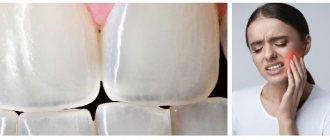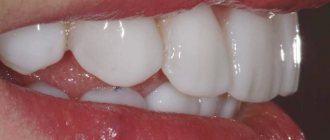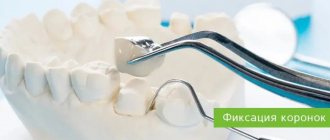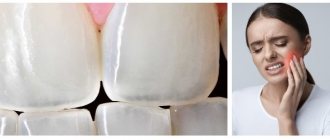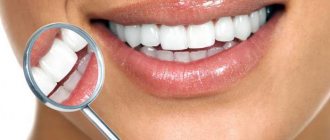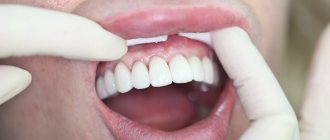- What kind of crowns are placed on teeth?
- Is it painful to grind down a tooth for a crown?
- Read more about teeth grinding
There are several reasons for using crown prosthetics.
Let us remind you that a crown is a tool for single prosthetics, which is used in the following cases: pathological pigmentation of teeth, violation of its anatomical shape, cracks, destruction of the coronal part by more than 60% of the tissue volume. To install a crown, the patient will need to go through the following steps:
- Diagnostics.
- Preparation of the tooth stump.
- Taking impressions.
- Making a crown.
- Fitting and final installation.
What kind of crowns are placed on teeth?
The following prostheses are used for dental prosthetics with crowns:
- Metal-ceramic is a budget-friendly, strong and durable crown option. The base of the prosthesis is metal, the top lining is ceramic. This ensures its strength and external aesthetics.
- All-ceramic - crowns for the front teeth are made from ceramic, since the material is not suitable for the significant chewing loads that are inherent in the lateral and chewing teeth.
- Zirconium dioxide is a premium material in modern orthopedics, used to restore both anterior and chewing teeth, as it has unsurpassed strength and naturalistic aesthetics today.
What are the main reasons for installing a crown on a tooth?
There is no need to install a crown on a healthy tooth, although theoretically this is quite possible.
Among the most common cases for which a patient needs dental prosthetics are:
- destruction of dental tissue by more than half. Occurs due to caries damage. Moreover, in order to install the pin into the root of the tooth, it must be strong and healthy;
- unimportant aesthetic appearance of the tooth. Heavy smokers and coffee lovers may develop pigment spots on tooth enamel. At the same time, the surface of the tooth darkens and it loses its appearance;
- destruction of tooth tissue due to external mechanical influences (non-carious tooth destruction);
- complete loss of a tooth. May occur as a result of serious diseases, such as periodontitis;
- prosthetics based on a “bridge” (removal of teeth adjacent to the damaged one).
What is meant?
Metal ceramics – two-layer prosthesis. The bottom layer is metal, the top layer is ceramic lining. In any case, such a product cannot be “thin”. This means that in order for the artificial tooth to be the ideal size, the stump will have to be considerably ground. In most cases, preparation will require depulpation of the nerve. Naturally, all this is done under local anesthesia, and the patient does not feel pain. Let us immediately note that while the dental technicians are making the prosthesis, the doctor will cover the ground tooth with a temporary “cap” in order to avoid hyperesthesia, a reaction to cold or hot.
Zirconium is not only the most durable and beautiful, but also the thinnest prosthesis. To install a zirconium dioxide crown, the tooth can be ground only slightly. In most cases, pulp preparation is not required. Many patients refuse anesthesia because there is no pain during the process of removing the top layer of enamel. If a person has a low pain threshold, then doctors use local or topical anesthesia so that the person feels physically and emotionally comfortable.
The thickness of the ceramic crown is average - between “thick” metal ceramics and “thin” zirconium. This means that the degree of grinding, and as a result, the level of trauma of the procedure, is determined individually in each specific case.
Author:
Mayorov Andrey Mikhailovich
Specialization:
orthopedic dentistry, dental prosthetics, implant installation
Preparatory activities associated with installing a crown on a tooth
There is a misconception that installing a crown on a tooth is a painful undertaking that takes a lot of nerves and strength from the patient. This is far from true.
A much more intolerable procedure is the treatment of caries with a drill, and preliminary grinding of the tooth before installing a crown is usually carried out on a “dead” tooth.
In addition, such procedures are carried out under local anesthesia using the most effective medications.
One of the main stages before prosthetics is removing plaque and removing tartar. It is often necessary to restore a tooth (if it is too damaged).
In general, preliminary preparation consists of removing the tooth root, filling the canals and installing a crown holding pin.
All these procedures are carried out under continuous monitoring using x-rays.
In rare cases, a crown may be placed on a living tooth. In these situations, local treatment of caries of the affected tissues is carried out, after which a prosthesis is placed on the tooth.
Each case is different, so before deciding to install a crown on a tooth, you should consult with your dentist.
Classification of dental crowns
Modern medicine does not stand still, and today a very wide variety of crowns of various types and materials has appeared.
According to their purpose, crowns can be of two types: restorative (a complete, functional and aesthetic product) and supporting (used to secure a “bridge”).
The crown can be made from the following materials:
- metal;
- metal composite;
- metal ceramics;
- ceramics;
- porcelain;
- zirconium.
Also, each crown is graded according to design:
- full crowns. Used to completely restore a lost tooth;
- equatorial crowns. A metal plate that covers the tooth to preserve its tissues and shape (partial damage to the tooth);
- stump crowns. A crown built onto the gum;
- half-crowns They completely replace the tooth on all sides and can also serve as a support for a “bridge”;
- telescopic crowns. They differ in that their height after installation can be adjusted (relative to the gum);
- pin, jacket, etc.
When is a doctor needed?
If your teeth ache for longer than 7 days after grinding, you should make an appointment with your doctor. The reason for contacting a specialist may also be:
- inflammation and bleeding of gums,
- the appearance of neoplasms on the mucous membrane,
- bad breath,
- pain when chewing and brushing teeth.
The listed symptoms cannot be ignored. Even with minor discomfort, it is better to consult a doctor to exclude the development of serious diseases.
Clinical case
A 30-year-old patient came to the clinic with complaints of darkening of fillings. The patient was interested in an aesthetic restoration with a long service life, so it was decided to restore the teeth with ceramic inlays. The initial situation is shown in Fig. 1. After collecting complaints, anamnesis, and conducting an examination, a diagnosis was made: K02.1 Dentin caries of a tooth 3.6, class II according to Black. K02.1 Dentin caries of tooth 3.7, Black class I.
Rice. 1.
At the clinical stage, the tooth was cleaned of plaque. After anesthesia, the color was determined using the standard VITAPAN Classical scale, the color of future indirect restorations is A2.
The preparation and formation of cavities of class I and II according to Black were carried out according to generally accepted principles in compliance with all stages with the obligatory use of a rubber dam to isolate the working field.
A small carious cavity was found on the medial contact surface of tooth 3.6, without destruction of the marginal ridge and without communication with the main carious cavity on the chewing surface. After preparing the carious cavity on the medial contact surface of the tooth, filling was performed using a fluid composite material.
Before taking the main impression, immediate dentin bonding was performed according to a traditional adhesive protocol. After polymerization of the adhesive, the undercuts in the area of the cavity walls were closed with a layer of flowable composite. The next step was to apply glycerin to the inner surface of the prepared cavity and illuminate it with a photopolymer lamp to remove the oxygen-inhibited layer in order to prevent possible interaction with the vinyl polysiloxane impression material during impression taking. The final view of the prepared cavity before taking an impression is shown in Fig. 2.
Rice. 2.
Impressions were taken with A-silicone impression material, temporary restorations were made using Clip material.
A follow-up visit took place 1 week later to fix the IPS e.max ceramic inlay. Previously, before admitting the patient, we assessed the marginal fit of the ceramic inlays on dismountable models (Fig. 3-6).
Rice. 3.
Rice. 4.
Rice. 5.
Rice. 6.
The second clinical stage began with cleaning the tooth from plaque. After anesthesia and the application of a rubber dam, the temporary restorations were removed, the cavity was cleaned of temporary cement residues, followed by fitting and preparation of ceramic inlays for fixation (Fig. 7-10). The indirect restoration was cemented using Calibra dual-curing adhesive composite cement (DENTSPLY).
Rice. 7.
Rice. 8.
Rice. 9.
Rice. 10.
After positioning the restoration, excess fixing material was removed in the area of the contact surfaces. Next, excess material was removed from other surfaces of the teeth. After 3 - 4 minutes, the surface of the fixing material was covered with a layer of glycerin and the final illumination of the restorations was carried out from each surface for 20 seconds.
At the final stage, an occlusion check was carried out. The view of the restoration immediately after fixation is shown in Fig. 11.
Ceramic restorations look natural, no different from your own tooth tissue.
Rice. eleven.
The appearance of the restorations 5 years after fixation is shown in Fig. 12.
Rice. 12.
How is filing of front teeth performed?
The technique of filing teeth varies depending on the condition of the oral cavity, the current diagnosis and treatment goals. Teeth filing begins with a detailed diagnosis. The specialist evaluates the feasibility of the procedure and identifies the teeth that need correction. For an accurate diagnosis, an examination is carried out, the causes of the disease are studied, and a treatment method is determined. The procedure consists of simple steps:
- Determination of the working area. For this, wax plates or special aerosols are used. The use of additional means allows you to mechanically highlight or paint an area that stands out from the general row and prevents the normal closure of teeth. In particularly advanced situations, it will be necessary to create a plaster model of the client’s jaw;
- Anesthesia if a large layer of hard tissue is to be removed;
- Direct filing with a diamond bur. On chewing teeth, the enamel is removed in the areas of protruding cusps. In the case of incisor processing, multidirectional movements are used to create the correct tooth shape;
- Grinding the surface, using products to replenish the deficiency of enamel minerals, as well as drugs to reduce sensitivity and strengthen dental tissue.
After filing, the thickness of the enamel changes, so sensitivity often increases. This phenomenon is temporary and for some time after treatment it is better to refrain from eating too hot or cold food. If the problem does not go away, it is better to consult a dentist.
